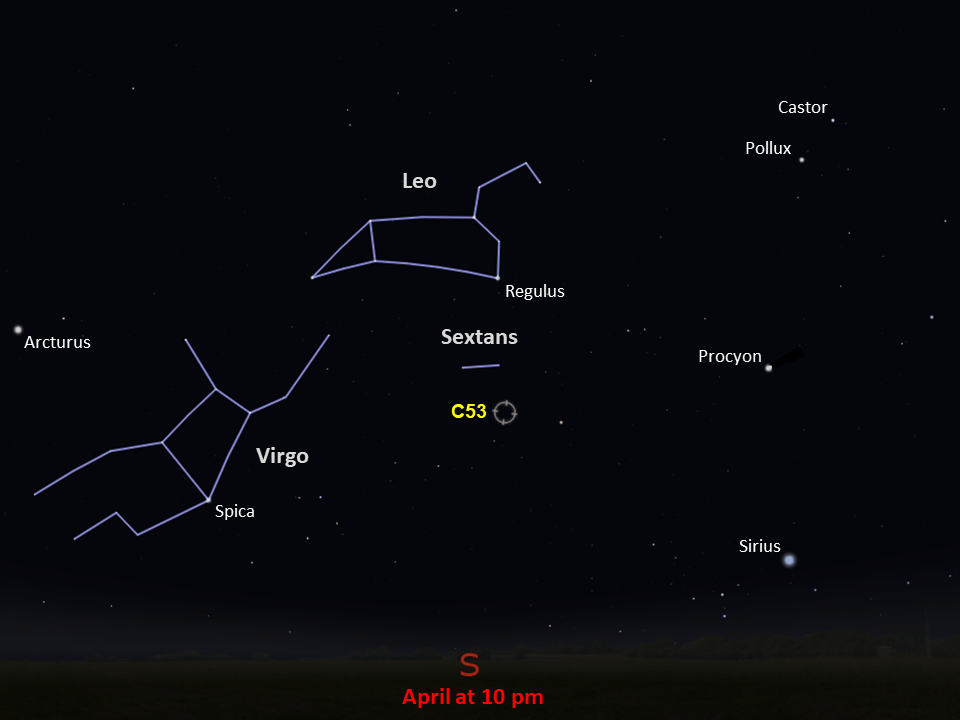Caldwell 53
Astronomers estimate that the black hole at Caldwell 53's heart has a mass roughly one billion times the mass of our Sun.
Distance
32 million light-years
Apparent Magnitude
9.9
constellation
Sextans
object type
Lenticular Galaxy

Lacking spiral arms but boasting a galactic bulge and prominent disk, lenticular galaxies like Caldwell 53 (NGC 3115) are intermediates between the more familiar spiral and elliptical galaxies. This galaxy, like most of its kind, hosts an elderly stellar population and has used up nearly all of its star-forming material. Appearing edge-on to us, the galaxy is located 32 million light-years from Earth in the constellation Sextans and has an apparent magnitude of 9.9. Discovered by William Herschel in 1787, it is most easily observed during early spring in the Northern Hemisphere and autumn in the Southern Hemisphere. As one of the brighter galaxies, Caldwell 53 can be easily seen in a small telescope, which will display the galaxy’s spindle-like form and bright central region.
Caldwell 53 is perhaps most notable for the supermassive black hole that lurks at its center. One of the ways astronomers are able to estimate the mass of a black hole is by observing the temperature of the hot gas being dragged toward it. Using this method, astronomers estimate that the black hole within Caldwell 53 has a mass roughly one billion times the mass of our Sun. This estimation means that Caldwell 53 hosts the closest billion-solar-mass black hole to Earth.
This image of Caldwell 53 is a composite of observations taken by Hubble’s Advanced Camera for Surveys at infrared and visible wavelengths. Scientists used information gathered from these observations to constrain the temperature and density of the gas that surrounds the supermassive black hole at the center of the galaxy.


Glossary
Apparent Magnitude - The brightness of an astronomical object as seen from Earth, influenced by the object's distance from Earth, its absolute magnitude, and even gas and dust that lie between the object and Earth.
Elliptical Galaxy - A nearly featureless, spherical or football-shaped galaxy, typically lacking new star formation and often containing much older stars than those in spiral galaxies.
Galactic Bulge - A dense collection of stars at the center of a spiral galaxy, possibly hosting a supermassive black hole.
Lenticular Galaxy - A galaxy that has qualities of both elliptical and spiral galaxies, sometimes called an armless spiral.
Spiral Galaxy - A galaxy characterized by its spiral structure, with star-filled arms that extend out from the center of the galaxy and host regions of star formation.
Supermassive Black Hole - A black hole millions or billions of times more massive than the Sun, typically residing at the center of a large galaxy.
Explore Hubble's Caldwell Catalog
The following pages contain some of Hubble’s best images of Caldwell objects.

Caldwell 1
Also known as NGC 188, this group of stars formed from a large cloud of gas making the stars roughly…

Caldwell 2
This shell of gas is expanding outward, away from the dying star within.

Caldwell 3
This barred spiral galaxy was first spotted by British astronomer William Herschel in April 1793 in the constellation Draco.




